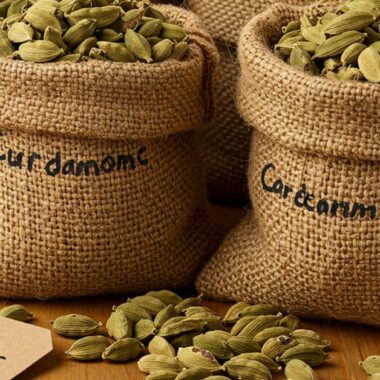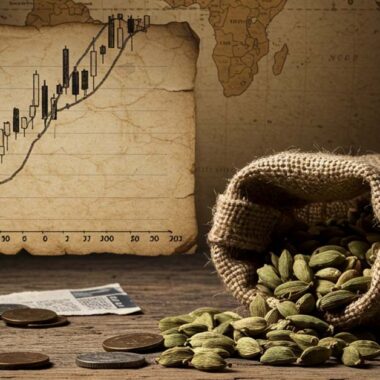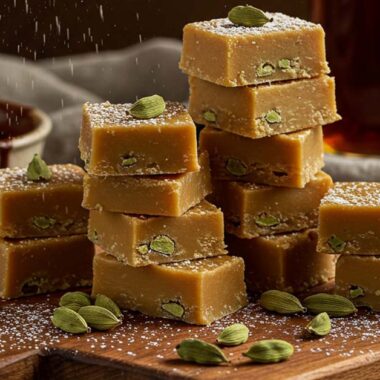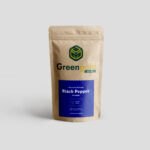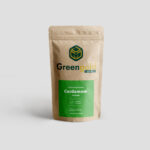Cardamom, often referred to as the Queen of Spices, holds a special place in various cultures around the world. Its unique aroma and flavor make it not just a prized spice in cooking but also an integral part of cultural traditions, health practices, and even spiritual rituals. Let’s explore how cardamom is valued across different countries and regions.
🇮🇳 India: The Heart of Cardamom Culture 🌶️
In India, cardamom is revered both for its culinary and medicinal properties. It’s a key spice in traditional Indian dishes, particularly in biryani, masala chai, and a variety of sweets like kulfi and kheer.
- Masala Chai: Cardamom plays a crucial role in masala chai (spiced tea), a beloved drink across the country. The warm, comforting blend of cardamom with cinnamon, ginger, and cloves is enjoyed by millions every day.
- Ayurveda: In Ayurvedic medicine, cardamom is considered a cooling spice that balances the body’s digestive system and detoxifies it. It’s often used to treat indigestion, nausea, and other digestive issues.
- Religious Significance: Cardamom also has spiritual importance. It’s used in some Hindu rituals and offerings, especially in temples, due to its sweet fragrance. It’s believed to purify the atmosphere and bring good luck.
🇸🇦 Middle East: A Symbol of Hospitality 🍽️
In the Middle East, cardamom is a prized spice, both for its culinary uses and cultural significance.
- Coffee: In countries like Saudi Arabia, Yemen, and Kuwait, cardamom is a key ingredient in Arabic coffee (qahwa). It’s mixed with lightly roasted coffee beans and is an essential part of the hospitality culture. Offering cardamom coffee to guests is a sign of respect and warmth.
- Desserts: Cardamom is used in various Middle Eastern desserts like baklava, halva, and ma’amoul (date-filled cookies), where it imparts a sweet and aromatic flavor.
- Traditional Medicine: In some cultures, cardamom is used in traditional medicine to treat ailments such as cough, digestive issues, and even stress.
🇪🇬 Egypt: A Spice with Medicinal and Culinary Uses 🍛
In Egypt, cardamom is an essential ingredient in both sweet and savory dishes.
- Cooking: It’s used in rice dishes, stews, and soups, where it adds a warm, slightly spicy flavor. Egyptians also use cardamom in tea and coffee to enhance flavor.
- Herbal Remedies: Traditionally, cardamom is used to treat digestive issues, such as indigestion, bloating, and gas. Its use in herbal teas is very common, often paired with ginger or cinnamon.
- Perfume and Incense: The Egyptians have also historically used cardamom in their fragrances and incense, highlighting its fragrant and calming properties.
🇸🇪 Sweden: A Flavorful Tradition 🥐
In Sweden, cardamom is a popular spice, especially in baked goods and traditional treats.
- Swedish Cinnamon Buns (Kanelbullar): While cinnamon is the dominant spice in kanelbullar, cardamom is a key ingredient that enhances the flavor profile, making these cinnamon buns even more delicious.
- Cardamom Coffee (Kaffekalas): Cardamom-flavored coffee is a popular tradition in Swedish households, especially when gathering with friends and family for a fika (coffee break).
- Christmas Treats: During Christmas, cardamom is used in Lussekatter (saffron buns) and pepparkakor (gingerbread cookies), where its warm and aromatic flavor complements other festive spices.
🇮🇹 Italy: A Touch of Elegance in Sweets and Beverages 🍨
In Italy, cardamom is mainly used in desserts and beverages, adding a unique twist to traditional recipes.
- Italian Pastries: Cardamom is often used in Italian pastries like biscotti, tiramisu, and panettone, where it provides a hint of warmth and spice.
- Coffee Culture: Italy’s coffee culture also incorporates cardamom, especially in specialty drinks like caffè corretto (coffee with a splash of alcohol), where the spice enhances the richness of the espresso.
- Liqueurs: Cardamom is a key ingredient in some traditional Italian liqueurs, such as Limoncello or Amaretto, where it’s used to infuse unique flavors.
🇮🇱 Israel: A Spice of Healing and Flavor 🍲
In Israel, cardamom is used both for its flavor and its medicinal properties.
- Spices in Cooking: Cardamom is a staple in Middle Eastern cuisine, and Israeli dishes often feature this aromatic spice in rice, stews, and vegetarian dishes. It’s also part of the spice mix used for shakshuka (a dish made of eggs poached in tomato sauce).
- Tea and Health: Cardamom is commonly used in herbal teas for its digestive benefits. It’s often paired with mint or ginger to help with indigestion or nausea.
🇲🇾 Malaysia: A Key Ingredient in Traditional Cuisine 🍛
In Malaysia, cardamom plays an important role in the preparation of spicy and aromatic dishes.
- Rendang and Satay: In Malaysian rendang (a spicy beef dish) and satay (grilled meat skewers), cardamom is used to create rich, deep flavors alongside other spices like cumin, cloves, and turmeric.
- Teas and Beverages: Cardamom is also found in Malaysian teas and local beverages, where it’s combined with other spices to make refreshing, flavorful drinks.
🇲🇻 The Maldives: A Spice of Luxury 🌴
In the Maldives, cardamom is considered a luxury spice used in special occasions and festive meals.
- Specialty Dishes: It’s often used in traditional dishes like Mas Huni (a Maldivian breakfast dish made of tuna, coconut, and spices), as well as in rice dishes and curries.
- Celebrations and Festivals: During celebrations and religious festivals, cardamom is used in special desserts and beverages served to guests.
🌍 Global Significance 🌿
Cardamom’s widespread use across different countries highlights its universal appeal and cultural significance. Whether in the form of flavoring food, enhancing beverages, or healing the body, cardamom transcends borders and connects people with its vibrant aroma and taste.
🌟 Conclusion: A Spice That Unites Cultures 🌏
Cardamom’s cultural significance is evident in the many ways it enriches life across the globe. From comforting chai in India to fragrant coffee in the Middle East, it’s a spice that plays an essential role in various culinary traditions, health practices, and celebrations. Whether you’re enjoying a cup of cardamom-infused coffee or using it in a luxurious dessert, this spice offers a taste of tradition, culture, and warmth.
Isn’t it fascinating how cardamom continues to bring people together, no matter where they are in the world? 🌿🌍

